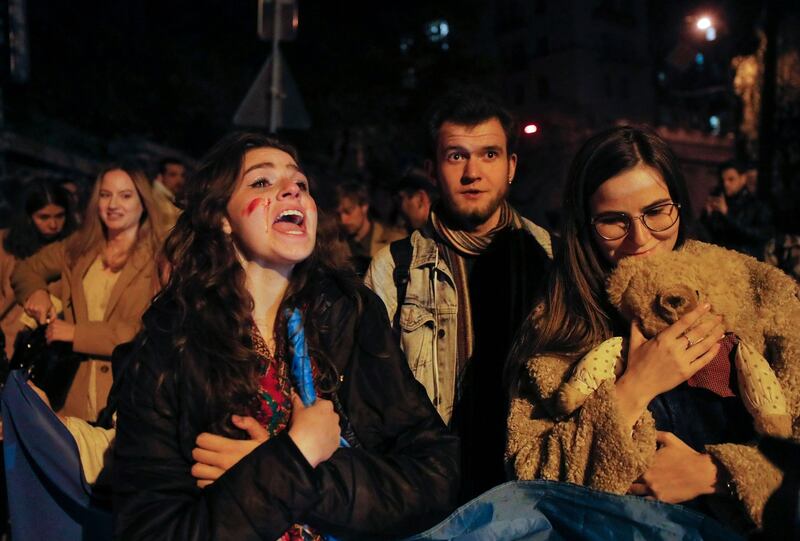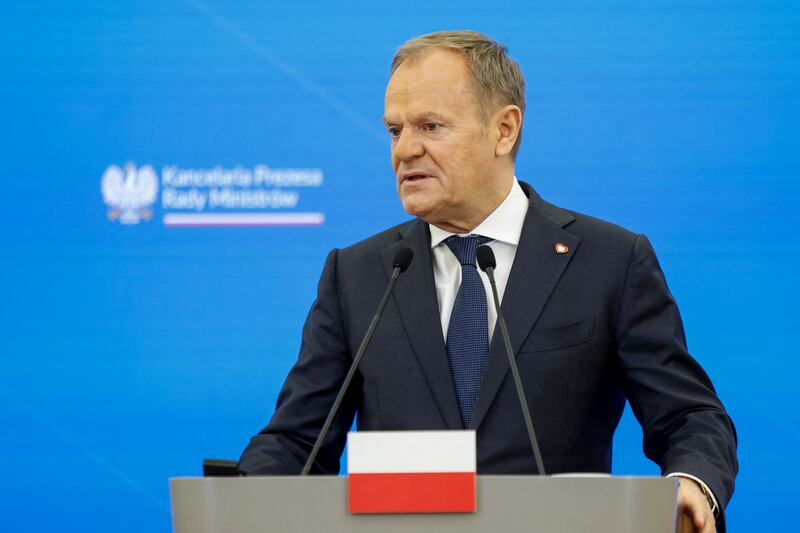“Bitches”, shouted the Ukrainian soldier. He had just fired his Kalashnikov light machine gun at several drones that were flying low and slow over central Kyiv on Monday morning, the tell-tale noise of their two-stroke engines identifying them as Iranian-made Shahed 136s.
Other troops nearby also lifted their rifles to the sky, aiming at the propeller-driven drones. Moments later, one crashed in a ball of flames into a street. Another went into a steep dive and exploded into a residential building next to the head office of an energy company.
“All night and all morning the enemy terrorises the civilian population. Kamikaze drones and missiles are attacking all of Ukraine,” President Volodymyr Zelenskiy said.
Foreign-made drones have been a feature of the war in Ukraine. First, Kyiv deployed Turkish-made TB2 Bayraktar drones to devastating effect against Russian troops. After the October 8th attack on the Kerch bridge connecting Russia to the occupied Crimean peninsula, Ukrainian and western defence officials say Moscow is increasingly turning to Iranian-made “kamikaze” drones, such as the Shahed-136, to take out Ukrainian targets.
With Kyiv reeling from another round of drone attacks on Monday, Ukraine has repeated calls for allies to send more robust air defence systems to protect its cities and key infrastructure.
“These Iranian drones are effectively cheap cruise missiles with a long range and good accuracy. While they are easier to shoot down, they are so cheap that you can use several to overwhelm air defences,” said Jeremy Binnie, Middle East specialist at Janes, a defence intelligence company.
Iran, which has the largest missile arsenal in the Middle East, has already provided Russia with hundreds of Shahed 136 drones, said US national security adviser Jake Sullivan.

Last week, Zelenskiy said Russia had ordered 2,400 more of the unmanned aerial vehicles, which are largely built from off-the-shelf components, can be programmed to fly automatically towards a set of GPS co-ordinates, and carry a hefty 30kg warhead. Iran repeated on Monday its denial that it is supplying drones to Russia. The Kremlin has not commented on the use of UAVs but said it was using precision weaponry to hit its targets.
The Iranian drones’ ease of use and relatively low cost of about $20,000 apiece, compared with more than $4 million for a cruise missile, mean they can be used in swarms.
That makes it harder and more expensive for Ukraine’s limited air defence systems to stop them. Alongside the longer-range Mohajer-6 drone, equivalent to a TB2, they can be used for stand-off strikes behind enemy lines and to sow fear among the civilian population.
“Only one drone needs to get through the air defences to hit the target,” said Binnie, who estimates that Iran has made several hundred of the Shahed-136 drones and still has plentiful stockpiles.
Ukraine’s military has said it had destroyed 37 drones since Sunday evening, about 85 per cent of the number launched.
[ Ireland set to provide training for Ukraine to clear Russian landminesOpens in new window ]
Still, the seriousness of the situation is reflected in how the attacks have wiped out a third of the country’s electricity infrastructure.
Tehran is also reportedly poised to send to Moscow Fateh-100 and Zolfaghar short-range ballistic missiles, according to the Washington Post.
Western officials believe that Russia’s use of Iranian armaments showed the depleted state of its own stock of precision weapons. Last week, top British spy Jeremy Fleming, head of the UK’s cyber agency GCHQ, said Russian president Vladimir Putin’s forces were in a “desperate” position.
On the battlefield, these shortages are seen in Russian forces’ increased recent use of surface-to-air and anti-ship missiles to take out land-based targets.
Russian colonel Igor Ischuk recently told the country’s Tass news agency that most of the country’s arms manufacturers “cannot meet” the army’s technical drone requirements due to a lack of components.
To replenish its missile stocks, Russia turned to Iran, which Putin visited in July. China was another possibility, but Beijing “was probably concerned that it would have to face heavy sanctions and a very strong US response if it transferred this type of military technology [to Russia]”, said Samuel Bendett, an adviser at the CNA think-tank.

Iran, by contrast, “has not only been able to manufacture its own line-up of UAVs, they’ve been doing it for decades and while under significant US sanctions”, he told the Grey Dynamics podcast.
Iran has a long record of military drone and missile operations. The US blamed the September 2019 strike that knocked out half of Saudi Arabia’s crude oil output on Tehran.
“Russia is behind Iran in this particular field [of drone warfare],” said Mehdi Bakhtiari, an Iranian defence expert. One Tehran-based political analyst added that sanctions forced the Islamic republic to focus on developing less sophisticated weaponry, such as drones.
[ A vital chronicling of the war in Ukraine, one brutal day at a timeOpens in new window ]
Iran and Russia have also long co-operated militarily, both intervening in Syria’s civil war in 2015 to turn the conflict in President Bashar al-Assad’s favour.
Even so, Iran has no direct stake in the Ukraine conflict, said Emile Hokayem, senior fellow for Middle East security at the International Institute for Strategic Studies think-tank in London. Nor did Tehran offer clear support for Russia’s September 23rd annexation of four Ukrainian provinces.
But analysts said that, apart from the welcome payments that heavily sanctioned Tehran would get for supplying the arms, deeper co-operation with Moscow now might win Iran access to defence technologies such as Russia’s Su-35 fighter jets.
The fact its weapons would be tested against western defence systems in Ukraine was also a propaganda win that might boost arms sales.
“Iran may be hoping to get things like fighter jets or maybe it wants to swap drones for wheat,” the Tehran-based analyst said. “Whatever [the reason] is, this is an opportunity for Iran.” – Copyright The Financial Times Limited 2022










